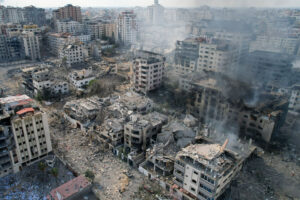Any evaluation of the ceasefire agreement between Israel and Hamas should, in fairness, start on a charitable note. It’s devilishly difficult to cajole parties that have been butchering one another, and loathe each other deeply, to stop fighting. Besides, there’s no such thing as a perfect ceasefire deal, even in the minds of those who sign it. They haggle as best they can, on the issues that matter to them, deciding how much ground they’ll give on key concerns even as they coerce their rivals to make the bigger concessions. But, in the end, neither side ever gets everything it wants.
More importantly, the agreement has made a huge difference to people’s lives, above all to Gazans. Those still living — at least 48,000 have been killed, even as The Lancet suggests that figure could be much higher — have been stalked daily by death, seen their homeland reduced to 42 million tons of rubble, and been deprived of life’s most basic necessities. That fear has been lifted, and hundreds of trucks laden with humanitarian aid have begun to enter the Strip. As for the family and friends of the hostages snatched by Hamas on October 7, they have waited in agony for the return of their loved ones, even as some know that all they can expect is their loved one’s corpse. Of the 33 hostages who are to be freed by the end of Phase 1 of the agreement, only seven have come home so far. The joy of the families, and of Israelis more generally, has been palpable. If everything goes according to plan, the remaining 61 hostages will be freed in Phase 2 of the agreement.
There’s more. Under the terms of Phase 1, the Israel Defence Forces (IDF) will redeploy to a narrow buffer-zone within Gaza’s border, before withdrawing completely by the end of Phase 2. Hamas is happy about this provision, but so are Gazans generally — it decreases the odds of the war’s resumption. Phase 3 calls for a detailed plan to rebuild Gaza, with satellite imagery showing 60% of buildings damaged or destroyed. Reconstruction, it goes without saying, is crucial if Gazans are to anything resembling normal lives.
Now that we’ve got the “in fairness” bit out of the way, let’s turn to the ways that the agreement could collapse, even before the 42 days of Phase 1 elapse, but more likely at the end of Phase 2 — an additional 42-day period when Hamas is required to release the remaining 65 hostages.
Could Hamas violate the deal? Of course. Recall that immediately after the ceasefire began, thousands of Hamas fighters and police appeared on the streets. Having endured punishing blows from one of the world’s most powerful armies and survived, and apparently recruiting enough fighters to replace those killed, Hamas has claimed victory. Such hubris could ultimately convince its leaders that Israel can be humiliated even further, via a renewed bout of fighting. Or, by reneging on its promise to release the hostages, Hamas may try to wring more concessions from Israel. It could, for instance, demand the freeing of even more Palestinian prisoners. That includes Marwan Barghouti of Fatah, the most famous (and popular) of all Palestinian prisoners. Since 2002, he’s been locked in an Israeli prison, serving five life sentences for murder. If Hamas ever demanded his release, or made additional demands, Israel would almost certainly say no — and the war would resume.
Yet, it’s hard to see why Hamas would wreck the agreement. The January 15 deal gives it just about everything it has long sought (and received, in a May 2024 accord, which Israel rejected). One important gain here is the IDF’s redeployment away from Gaza’s major population centres, as a prelude to a complete withdrawal. Another is Israel’s release of nearly 2,000 Palestinian prisoners, based on an overwhelmingly favourable hostage-for-prisoner ratio, and that’s before you recall the comprehensive plan for rebuilding Gaza.
Why would Hamas abandon these gains — especially when there’s not much more it can realistically squeeze from Israel, and when reigniting the war would inflict far more pain on Hamas than the IDF? The point here is not that Hamas is fastidious about honouring the terms of deals it signs, merely that, like other states and groups jousting in the pitiless arena of international politics, it’s a self-interested actor.
Israel, on the other hand, does have reasons — again based on self-interest — to breach the terms of the peace. Netanyahu vowed that he would continue the war until Hamas was destroyed: not just diminished but totally wiped out. He has failed to achieve that goal, something the IDF has itself acknowledged. Worse, Hamas has replenished its ranks and rebuilt much of the labyrinthine tunnel network, the very same infrastructure that made freeing the hostages so challenging for Israeli troops.
Netanyahu, in short, has unfinished business, and has openly stated he reserves the right to restart the war. No less striking, the prime minister is under pressure from his own coalition. One of his hardline cabinet members, Itamar Ben-Gvir, national security minister and head of the Otzma Yehudit party, resigned in protest after Netanyahu agreed to sign the ceasefire deal. Ben-Gvir urged Bezalel Smotrich, another hardliner, to follow suit. Netanyahu persuaded Smotrich to stay by promising (among other things) that the ceasefire wouldn’t mean a permanent end to the war. Smotrich, for his part, has publicly highlighted this assurance.
For good measure, the finance minister added that there would be “a gradual takeover of the entire Gaza Strip” to ensure that “humanitarian aid will not reach Gaza as it has until now.” To summarise, then, Netanyahu has consistently sought to ensure that he has the support of the far-Right religious parties. But if he delivers on his deal with Smotrich, defenestrates the ceasefire, and restricts aid flows once more, the whole arrangement will collapse.
And what of Donald Trump? He paraded the ceasefire, which he clearly wanted signed before Inauguration Day, as something he alone made happen. Wouldn’t its implosion make his boast seem hollow, and make his coveted Nobel Peace Prize even less likely? None of this is likely to be as big a problem as it might seem. Trump makes lots of promises — remember his vow to end the Ukraine war within 24 hours of being sworn in? — and takes credit for all manner of things. But his base expects this, so he won’t pay any political price if the Gaza war restarts. If the bloodshed resumes, he’ll blame Hamas, or Netanyahu, or perhaps even Biden.
The American domestic context matters here too. Trump has long relied on the support of groups and individuals, both Jewish and Evangelical, unconditionally supportive of Israel. The President, who always fancies himself a maverick, could break faith with these supporters. Yet nothing he has done with respect to Israel suggests he’s so inclined. During his first presidential term, after all, he moved the American embassy from Tel Aviv to Jerusalem. Accepting Israel’s claim that the unified city is its eternal capital, that’s something only five other countries have done.
Trump also recognised the Golan Heights — Syrian sovereign territory that Israel occupied after the Six-Day War in 1967 — as legally part of Israel. In 2023, meanwhile, he declared that Israel has “no better friend or ally” than him. No sooner did his current term start than he lifted the sanctions Joe Biden had imposed on far-Right settlers building illegal settlements in the West Bank. Soon after that, he nixed Biden’s ban on supplying 2,000-pound bombs to Israel. Plus, Trump has apparently assured Netanyahu that Israel would enjoy his full backing to restart the fight if Hamas violates the deal. In fact, the prime minister has already accused the militants of doing just that, and responded by temporarily blocking displaced Gazans from returning to the territory’s north.
None of this means that Israel, confident of US backing, is sure to breach the ceasefire. Nor is it necessarily planning to, especially since the hostages won’t all be released until the end of Phase 2. Though he’ll have more flexibility thereafter, Netanyahu may yet decide to stick with the agreement. For one thing, he may be deterred by the surprisingly high casualty rates among the IDF, with nearly 900 battle deaths in Gaza alongside 38 suicides. For another, Netanyahu may be unsure whether Hamas can truly be destroyed. Still, of the two parties that have signed the deal, Israel has stronger motives to breach it than Hamas — something to bear in mind if violence really does return.
Disclaimer
Some of the posts we share are controversial and we do not necessarily agree with them in the whole extend. Sometimes we agree with the content or part of it but we do not agree with the narration or language. Nevertheless we find them somehow interesting, valuable and/or informative or we share them, because we strongly believe in freedom of speech, free press and journalism. We strongly encourage you to have a critical approach to all the content, do your own research and analysis to build your own opinion.
We would be glad to have your feedback.
Source: UnHerd Read the original article here: https://unherd.com/




